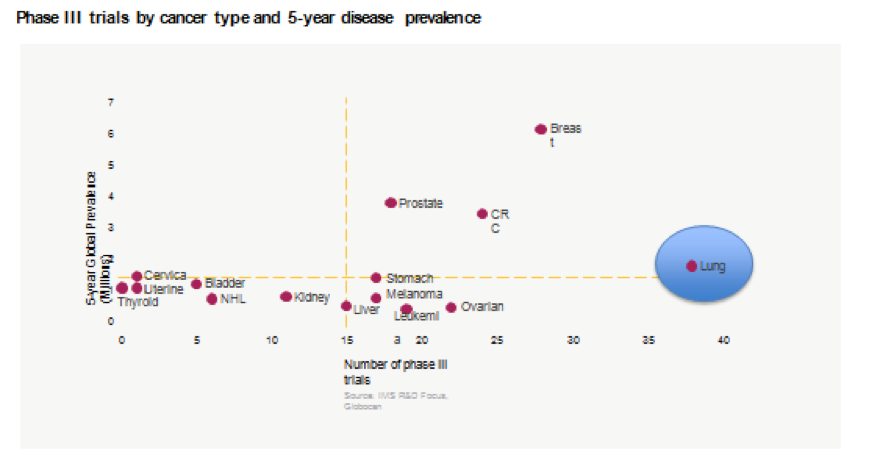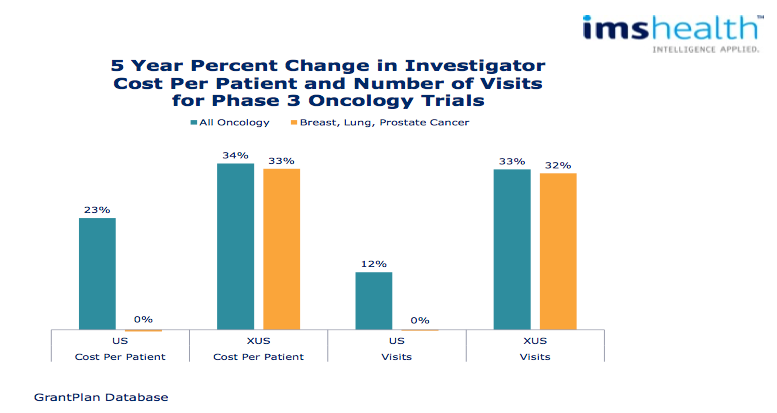Breathe Easier...Oncology R&D Innovation Puts Strong Focus on the Lung
IMS Health
IMS Health
Innovation in Oncology continues to dominate the drug development pipeline, with accelerated approvals, increased funding and awareness, and an overall pipeline of almost 2,000 active products under study accounting for 1/3 of all R&D. However, while many Oncology indications are experiencing success in life extension with overall 5 year survival rates at over 66%, others such as lung cancer are struggling to achieve the same results1 with a mere 16.8% achieving 5 year survival. While lung cancer survival rates may be low, innovation is at an all time high. Extended survival of lung cancer patients has now become a large industry investment.

However, an interesting finding is that we have remained cost neutral in the US across the last 5 years in R&D cost-per-patient spend, in addition to remaining visit neutral in the area of lung cancer research. Ex-US has experienced the opposite—with a correlation between increased patient visits and increased per patient spend. What is fueling this increase in activity? Is this purely a result of globalization of research over the past 5 years? Perhaps US has become more efficient in execution thus controlling spend, but with little new outcomes?
One item of note is that the IMS cost data is the investigator cost-per-patient. Therefore, items like biomarkers and genetic testing performed centrally, and associated costs, are not a consideration in this evaluation. This is something that should be explored further to identify if in fact the US is truly cost neutral. With respect to ex-US increases—now that some ex-US countries are becoming established, are they demanding more money? IMS is continuing to invest in understanding these drivers in the lung cancer research market.

With almost 40 Phase III trials in play focused specifically on lung cancer treatment, industry is seeking new ways to re-innovate innovation. A recent example of this is the novel lung cancer 14-in-1 trial run by both Pfizer and AstraZeneca. Researchers will test 14 drugs in one trial, doing away with the concept of randomization for “control “ mechanism given the incurable nature of the disease, and offering a more genetically focused, nimble, time and cost efficien,t and results-driven approach to lung cancer trial optimization, which could result in significant reduction in time to market.
With a wide spread industry search shying away from blockbusters and instead focused on genetic components, success through collaborative innovation is prompting strategic partnerships evolving across major players in R&D aimed at “re-writing the rule book on clinical trials”—Harpal Kumar, Chief Executive of Charity Cancer Research UK. Stay tuned as this is an exciting collaborative approach aimed at breathing new life into a disease with historically low survival rates.
1. Metric from SEER; 2004-2010
Improving Relationships and Diversifying the Site Selection Process
April 17th 2025In this episode of the Applied Clinical Trials Podcast, Liz Beatty, co-founder and chief strategy officer, Inato, discusses a number of topics around site engagement including community-based sites, the role of technology in improving site/sponsor relationships, how increased operational costs are impacting the industry, and more.
Behind the Buzz: Why Clinical Research Leaders Flock to SCOPE Summit
February 7th 2025In this episode, we meet with Micah Lieberman, Executive Conference Director for SCOPE Summit (Summit for Clinical Ops Executives) at Cambridge Innovation Institute. We will dive deep into the critical role of collaboration within the clinical research ecosystem. How do we bring together diverse stakeholders—sponsors, CROs, clinical trial tech innovators, suppliers, patients, sites, advocacy organizations, investors, and non-profits—to share best practices in trial design, program planning, innovation, and clinical operations? We’ll explore why it’s vital for thought leaders to step beyond their own organizations and learn from others, exchanging ideas that drive advancements in clinical research. Additionally, we’ll discuss the pivotal role of scientific conferences like SCOPE Summit in fostering these essential connections and collaborations, helping shape the future of clinical trials. Join us as we uncover how collective wisdom and cross-industry partnerships are transforming the landscape of clinical research.